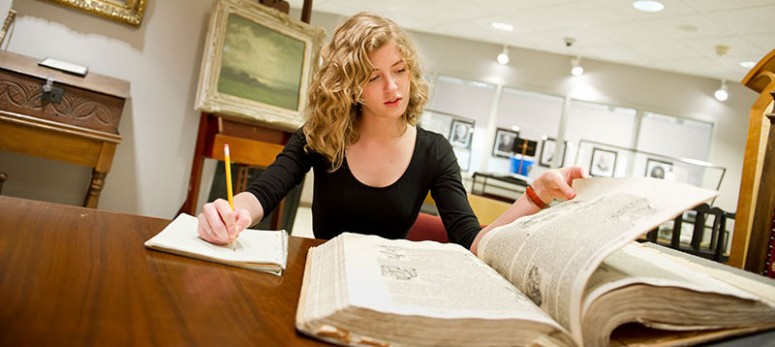Summer Scholars

From Kenyon News - May 30, 2014
First there was science.
Then there was, well, everything.
Undergraduate research has been a part of Kenyon going back at least until the early 1980s, when the Summer Science Scholars program was born. Now the College is instituting a new program in the humanities and social sciences, with the goal of extending research opportunities next summer to the fine arts — and beyond.
“I think it’s time to kind of step back and do a larger umbrella for undergraduate research, like many other institutions are doing,” Associate Provost Brad Hartlaub said. “I think having that opportunity for every discipline, every major, every student, if they’re interested in it, I think that would be a great thing.”
This year is the first for the Kenyon Summer Scholars program, a three-year pilot program that offers students in the humanities and social sciences a chance to conduct research alongside faculty. In 2013, the Center for the Study of American Democracy (CSAD) began awarding a scholarship for a student to partner with a faculty member to produce scholarly work. And in the summer of 2007, the John W. Adams Scholars Program in Socio-Legal Studies was the first at Kenyon to promote research outside the natural sciences.
The goal is to ride the wave of Summer Science’s success into the future of endowed programming. “Our external reviewers basically said to us, yes, it’s going to be costly to expand the summer science undergraduate research program,” Hartlaub said. “But for a college of Kenyon’s caliber to not expand it, that’d be even more costly.”
Two weeks after the new Summer Scholars program was announced, the provost’s office received 19 applications for four slots. Five were chosen.
“I can’t imagine that professors at big research universities would do one-on-one research with undergraduates [the] way this program does it,” said one of those students, John Zito ’16, who will be working with P.J. Glandon, assistant professor of economics, using drug and grocery store sales data to explore how competitiveness and price flexibility are related.
Joining Zito in the new program will be Emily Bulik-Sullivan ’16, exploring the merits of Italian writer Giovanni Boccaccio in the 15th-century Iberian court system; Damaris “September” Garduno, researching the role of minority communities in rural Ohio; Mary Shannon, arguing for a crossroads between an historical and universal approach to narrative studies; and Nick Rogers ’15, investigating the political power of medieval aristocratic women.
And the popularity of the prospect of doing research is not limited to the new program. The summer legal scholars program is seeing record-breaking interest, with 10 scholars this year, according to Ric Sheffield, professor of sociology and legal studies, who oversees the program.
“I think in some ways our program not only affords the opportunity to students,” Sheffield said, “but it affords the opportunity to faculty to find creative and valuable ways to work and collaborative ways with undergraduate students.” And that partnership between student and professor — rather than a student independent study project — is exactly what the College is hoping to build upon.
As a socio-legal scholar last summer, Mary Bank ’14 studied how young adults receive and internalize messages about alcohol and drugs. “The experience itself was just as valuable as what I was interested in studying,” she said of conducting research. “I think Kenyon does a really good job of being able to provide these very real-world, applicable opportunities where you wouldn’t otherwise get them.”
Years-long talk about extending the research opportunities granted by the Summer Science program came to a head in 2012. That year, Kenyon was chosen to host a Council of Undergraduate Research workshop to continue exploring how to expand undergraduate research. Afterward, a larger group of faculty continued the talks, among them Abbie Erler, associate professor of political science.
“I think all too often we think of research as this very solitary activity that you do sort of hidden away in your office,” Erler said. “No. It’s very much a social process.”
In November 2013, the 16-faculty group submitted its proposal, and President Sean Decatur and Provost Joseph Klesner gave the green light, granting funds to move forward with the pilot program.
And at the end of that pilot, instead of an individual scholars program, Hartlaub said, it’s possible that “we call all of them Kenyon Summer Scholars and we have a science component, a legal component, a CSAD component, a social scientist component. But it’s all under one big umbrella – undergraduate research.”
Hartlaub stressed, though, that the extension of the program would not detract from the advances made in the original science program.
“There’s a little bit of nervousness in the sciences about … taking away from the successful Kenyon Summer Science program to build something else, and the answer to that is an emphatic no,” he said. “We’re looking for expansion, not redistribution.”
And administrators and faculty are hoping that this expansion can provide students with skills that can last them a lifetime.
“It’s almost like riding a bike the first time, or the first dance, or the first date,” Hartlaub said. “The first research experience — you don’t forget it.”
By Henri Gendreau ’16